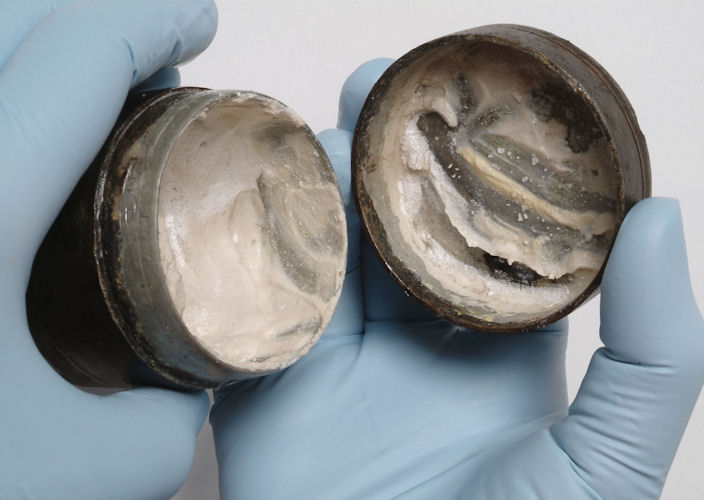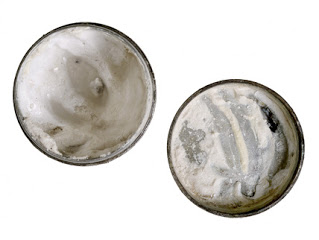2,000-Year-Old Roman Face Cream With Visible, Ancient Fingermarks
A 2,000-year-old cream was discovered inside a sealed Roman jar, replete with fingerprints. The metal item, which measures 6cm in diameter and is in good condition, was discovered during excavations at a Roman temple complex in Southwark, London.
Experts from the Museum of London raised the cover of the spherical metal pot. The finding of the white substance with a sulfurous odour surprised and delighted archaeologists.
“I am astounded,” said Garry Brown, managing director of Pre-Construct Archaeology whose team of archaeologists has been painstakingly excavating the Tabard Square site over the past year. “It appears to be a kind of cosmetic cream or ointment. Creams of this kind do not ordinarily survive into the archaeological record, so this is a unique find.”
Further scientific analysis will determine whether the paste was used for medicinal or cosmetic purposes.

“This discovery is absolutely remarkable. The cream could be face paint applied as part of ritual ceremonies. We know that the Romans used donkey’s milk for the skin, so the scientific analysis will be very revealing”, said Francis Grew, curator at the Museum of London. “In my 20 years working in London archaeology, I have never come across a box with a sealed lid.”
“Only two similar containers, both without lids, have been found in London and both were in-market sites,” added Elizabeth Barhan, conservator at the Museum of London.
“It is a fantastic human element to find the finger marks on the inside of the lid,” said Nansi Rosenberg, senior archaeological consultant at EC Harris, the consultancy which is managing the excavation. The imprints could shed further light on whether the pot was used by an adult or child, male or female.
Although at the moment there is no indication as to who might have placed the container in the sealed ditch, it is believed the drain in which it was found may have had a ritual significance.

The box is one of many items found at the site of the temple complex, one of the most important Roman sites discovered in Britain in the last 10 years.
The temple complex has been dated to the mid-2nd century AD, but the site was occupied from the earliest days of the Roman occupation, with clay and timber shops springing up around AD 50 on the Watling Street side of the site. Key finds include the Tabard inscription, which shows the earliest known naming of London, “Londinesi”, as well as a second tin object – a wide-mouthed bowl – and a life-size bronze foot.
Chemical tests on the pristine pot, which also has small circular grooves on the outside, have shown it to be made almost entirely of tin.
“The quality of the box is exquisite,” said Mr Grew. “The cap fits perfectly, it is water-tight and secure. Whoever used this pot would have been from the bourgeoisie of the Roman world. Tin was a precious metal at this time.”
“We’re lucky in London to have a marshy site where the contents of this sealed box must have been preserved very quickly – the metal is hardly corroded at all” added Ms Rosenberg.
The discovery of two Romano-Celtic temples along with a possible guesthouse has been an exciting and significant find: “It alters our whole perception – Southwark was a major religious focus of the Roman capital,” said Ms. Rosenberg.
The box and its contents will be immediately placed on display at the Museum of London, along with other key finds.
“The quality of the box is exquisite,” said Mr Grew. “The cap fits perfectly, it is water-tight and secure. Whoever used this pot would have been from the bourgeoisie of the Roman world. Tin was a precious metal at this time.”
“We’re lucky in London to have a marshy site where the contents of this sealed box must have been preserved very quickly – the metal is hardly corroded at all” added Ms Rosenberg.
The discovery of two Romano-Celtic temples along with a possible guesthouse has been an exciting and significant find: “It alters our whole perception – Southwark was a major religious focus of the Roman capital,” said Ms. Rosenberg.
The box and its contents will be immediately placed on display at the Museum of London, along with other key finds.
The unveiling coincides with a call by the Mayor of London, English Heritage and the Museum of London for more Londoners to get involved in archaeology through the launch of the Research Framework for London Archaeology.




